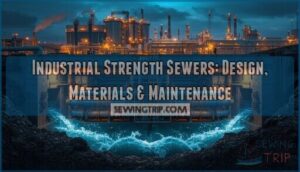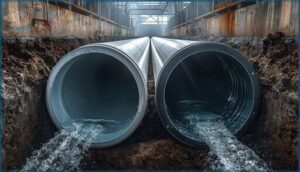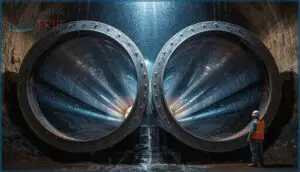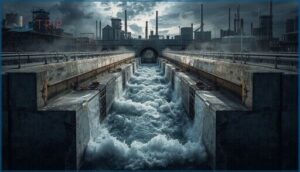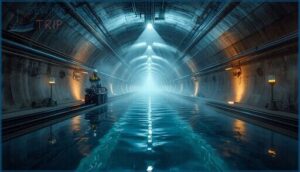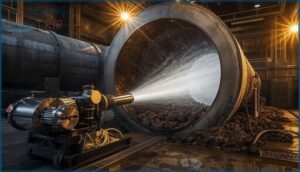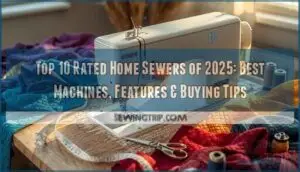This site is supported by our readers. We may earn a commission, at no cost to you, if you purchase through links.
When a pharmaceutical plant discharges 50,000 gallons of chemically laden wastewater every day, standard residential piping doesn’t just fail—it corrodes, fractures, and creates environmental hazards that can shut down operations overnight.
Industrial strength sewers are purpose-built systems engineered to handle extreme flow volumes, aggressive chemical compositions, and continuous operational demands that would destroy conventional drainage infrastructure within months.
These specialized networks integrate reinforced materials like Schedule 80 PVC and ductile iron, corrosion-resistant linings, and strategically positioned access points that enable proactive maintenance before minor issues escalate into costly failures.
Understanding how industrial sewers differ in design, material selection, and performance requirements gives you the technical foundation to specify systems that protect both your facility and the downstream environment for decades.
Table Of Contents
Key Takeaways
- Industrial sewers require specialized materials like Schedule 80 PVC and ductile iron that resist chemical attack and handle flow rates up to 500 gallons per capita daily—far beyond what residential piping can manage.
- Your material selection directly determines system lifespan, with properly specified PVC, HDPE, and ductile iron pipes rated for 50 to 100 years of continuous service under harsh conditions.
- Proactive maintenance using camera inspections and targeted cleaning every 3 to 6 months cuts repair costs by roughly 30% compared to reactive approaches that wait for failures.
- Regulatory compliance isn’t optional—you’ll face NPDES permit requirements, annual inspections, and strict effluent limits that demand ongoing monitoring and pretreatment protocols.
What Defines Industrial Strength Sewers?
Industrial strength sewers aren’t just scaled-up versions of what you’ll find under your home. They’re engineered systems built to handle dramatically higher volumes, harsher chemical loads, and decades of continuous operation under demanding conditions.
Understanding what sets these systems apart starts with three fundamental characteristics that define their design and function.
Key Features and Capabilities
Industrial strength sewer systems handle extreme demands you won’t see in ordinary settings. You’re working with pipes that maintain minimum velocities of 2 feet per second at one-third peak flow, preventing solids deposition while managing flows up to 500 gallons per capita daily.
These systems integrate corrosion prevention through specialized linings, paired with sewer cleaning equipment access points that support maintenance optimization and long-term pipe maintenance reliability. Regular maintenance is essential for preventing issues related to sewer cleaning methods.
Differences From Residential Sewer Systems
When you compare residential laterals to commercial-grade systems, the gap is striking. Flow Rate Comparison reveals homes usually use 4-inch lines handling modest loads, while industrial-strength networks demand 8- to 24-inch mains engineered for peak Industrial Water Usage from process equipment and multiple fixtures discharging simultaneously.
Key distinctions you’ll encounter:
- Pipe Material Selection: Residential systems rely on Schedule 40 PVC, whereas Industrial Sewer Maintenance requires Schedule 80 or ductile iron to withstand chemical attack.
- Wastewater composition: Domestic sewage averages 300 mg/L BOD; industrial effluent carries heavy metals, solvents, and variable organic loads.
- Sewer System Complexity: Commercial properties integrate grease traps, interceptors, and monitoring manholes—features absent in simple home laterals.
- Drainage Network Design: Multi-tenant sites often segregate industrial and sanitary lines; residential properties use single laterals.
- Sewer Cleaning Equipment access: Industrial layouts include sampling points and access structures for routine Pipe Maintenance and compliance testing.
You’ll also face stricter pretreatment standards and continuous monitoring obligations that residential connections never encounter, driving investment in specialized Sewer Maintenance protocols. Understanding commercial plumbing systems is essential for effective industrial sewer design and maintenance.
Typical Industrial Applications
Food processing plants discharge over 30,000 gallons daily, making rigorous wastewater treatment indispensable.
Chemical disposal from pharmaceutical and electroplating facilities demands corrosion-resistant industrial plumbing and strict pretreatment.
Textile mills and pulp operations rely on industrial sewer maintenance to manage high solids and BOD.
You’ll need industrial strength sewer solvent, sewer cleaning equipment, and industrial cleaning services to sustain wastewater management solutions across these diverse environments.
Materials Used in Industrial Sewer Construction
The materials you choose for your industrial sewer system directly impact its durability, chemical resistance, and operational lifespan. Modern construction relies on a range of pipe materials, each engineered to meet specific depth requirements, load conditions, and environmental challenges.
Understanding the strengths and specifications of these materials helps you make informed decisions that balance performance with long-term reliability.
PVC and HDPE Pipe Benefits
When you’re building for the long haul, chemical resistance and corrosion prevention matter. PVC and HDPE pipes deliver outstanding pipe durability—they won’t rust, scale, or degrade from harsh industrial effluent.
This sustainability benefits your operation through lower plumbing maintenance costs and fewer drain maintenance services. Material comparison studies confirm both options are PVC safe, requiring minimal pipeline cleaning and maintenance while supporting reliable pipe care and repair schedules.
Ductile Iron and Steel Pipe Specifications
You’ll often encounter pipe material comparison questions when selecting between ductile iron and steel. Ductile iron offers enhanced corrosion resistance with a 24 million psi modulus, while steel requires additional coatings for joint integrity.
Flow capacity improves with ductile iron’s larger internal diameter—up to 64 inches. Durability testing confirms 50-100 year lifespans, reducing your pipe care and repair needs and sewer line cleaning frequency, even when using standard sewer cleaning equipment.
Concrete Pipe Applications and Strengths
You’ll find concrete pipe dominating water management systems for good reason—compressive strengths reach 60 MPa, with Class 120 designs handling 72 kN/m crushing loads.
Concrete durability extends past 100 years in wastewater management applications, even with aggressive industrial conditions.
This pipe material resists corrosion while maintaining sewer infrastructure integrity, reducing your sewer maintenance frequency and pipeline cleaning demands compared to alternatives requiring frequent sewer line cleaning interventions.
Design and Flow Requirements for Industrial Sewers
When you’re engineering industrial sewers, sizing isn’t guesswork—it’s calculated against peak flow rates, maximum daily demand, and decades of operational stress. Your design decisions today will dictate whether the system manages tomorrow’s industrial loads or becomes tomorrow’s liability.
Industrial sewer design is calculated engineering against peak flows and decades of stress—not guesswork that becomes tomorrow’s liability
Let’s examine the critical engineering parameters that separate resilient infrastructure from costly failures.
Sizing for Peak and Maximum Flow Rates
Designing industrial sewers requires you to account for peak flows that can reach 2 to 4 times your average rate—a critical calculation for preventing system overload. You’ll need minimum 8-inch diameter pipes with velocities between 2 and 10 feet per second to maintain self-cleansing action while avoiding erosion.
Flow rate monitoring ensures your pipeline sizing methods match actual demand, protecting infrastructure integrity and optimizing water flow through strategic drain cleaning solutions and sewer maintenance schedules.
Engineering for High-Demand Environments
When you’re engineering for high-demand environments, precision in Flow Rate Calculations and Pipe Material Selection forms your foundation. You’ll need System Automation to manage surges while Hydraulic Optimization ensures consistent velocities. Pressure Management systems protect infrastructure during peak loads.
Consider equipment from specialists like Sewer Equipment Co of America—their sewer jetters, combination sewer cleaners, and water recycling sewer cleaners deliver the reliability your high-capacity system demands for uninterrupted operation.
Lifespan and Replacement Considerations
Pipe degradation accelerates when mortar linings crack or corrosion compromises metal substrates, so material selection directly affects replacement costs over decades. You’ll extend infrastructure life by prioritizing PVC or ductile iron—both rated for 100-year service—and adopting proactive maintenance scheduling.
Lifespan extension depends on condition-based inspections and tools from Sewer Equipment Co of America, including sewer jetters and combination sewer cleaners that prevent costly emergency replacements.
Maintenance and Performance Standards
You can’t just build an industrial sewer system and walk away—maintaining peak performance requires consistent monitoring and intervention.
Regular cleaning, inspections, and performance tracking keep your infrastructure running reliably while catching small problems before they escalate into costly failures.
Let’s look at the maintenance practices, performance indicators, and regulatory standards that define operational superiority in industrial sewer systems.
Routine Cleaning and Inspection Practices
You’ll want to establish a cleaning schedule that matches your facility’s demands—high-usage environments usually need pipe cleaning every 3–6 months, while moderate-use systems can extend to 6–12 months.
Modern sewer inspection relies on camera-equipped trucks to identify blockages before you deploy sewer cleaning equipment.
This targeted approach to drain maintenance cuts costs by 30% compared to blanket cleaning, focusing your drain flow efforts where sewer line cleaner and sewer solvent applications truly matter for clog prevention and sewer safety.
Indicators of System Performance
Once your sewer cleaning equipment finishes its work, you’ll need reliable performance metrics to judge results. Flow monitoring systems track hydraulic capacity against design benchmarks, while pipe integrity assessments detect structural weaknesses before failure analysis becomes necessary.
Watch for infiltration rates exceeding 4,000 gallons per day per inch diameter per mile—that’s your cue for immediate clog removal and targeted wastewater treatment interventions using municipal equipment.
Regulatory Requirements and Compliance
Beyond tracking infiltration, you’ll navigate a complex web of federal and local permit enforcement tied to effluent limits set under the NPDES program. Your facility must conduct routine wastewater monitoring and submit compliance reporting to document flows and pollutant concentrations at wastewater treatment plants.
- Secondary treatment standards usually mandate BOD and TSS not exceeding 30 mg/L as a 30-day average
- Control authorities inspect significant industrial users annually, escalating frequency when violations surface
- Local ordinances prohibit dilution as a substitute for pretreatment, requiring sewer solvent or municipal equipment upgrades
Regulatory standards guarantee your sewer line cleaner protocols align with both plant protection and downstream water quality goals.
Preventing and Addressing Industrial Sewer Clogs
Even the most sturdy industrial sewer system won’t remain effective without addressing the inevitable reality of clogs and blockages. Your facility’s operational continuity depends on both preventing these obstructions before they occur and responding quickly when they do.
Let’s examine the specialized cleaning solutions, common causes of industrial blockages, and proven strategies that keep your sewer infrastructure running reliably for decades.
Industrial-Grade Drain Cleaning Solutions
You’ll need to choose between mechanical and chemical approaches when tackling industrial sewer blockages. Mechanical cleaning technology, including hydro-jetting and drain snake equipment, removes obstructions without damaging pipe materials—usually costing $250 to $800 per treatment. Chemical solutions like grease dissolvers offer faster fixes but require strict chemical safety protocols and proper handling.
| Method | Best For |
|---|---|
| Mechanical (Hydro-jetting, Drain Snake) | Severe blockages, long-term pipe protection, root removal |
| Chemical (Sewer Line Cleaner, Grease Dissolvers) | Quick maintenance, light obstructions, routine drain cleaner applications |
| Combined Approach | Complex industrial cleaning demands requiring immediate action and sustained sewer maintenance |
Causes of Blockages in Industrial Systems
Understanding what causes blockages helps you prevent catastrophic failures. Solid waste and FOG buildup account for nearly half of industrial clogs, while mineral scaling reduces pipe diameter by 30% in untreated systems. Structural defects contribute to 18–25% of incidents, and hydraulic overload triggers backups during peak flows.
Regular grease trap cleaning and targeted clog removal with drain cleaner or sewer solvent address these issues effectively.
Strategies for Long-Term Sewer Reliability
Proactive strategies guarantee your infrastructure delivers decades of reliable service. You’ll prolong system longevity through:
- Asset Management programs that integrate flow monitoring and risk assessment to prioritize interventions
- Pipe Rehabilitation using trenchless methods, extending life by 50+ years
- Maintenance Optimization with scheduled grease trap cleaning and targeted sewer solvent application
- Corrosion Protection through material-specific treatments
- Water Flow Optimization via data-driven clog removal methods
These approaches reduce emergency repairs by 40%.
Frequently Asked Questions (FAQs)
How much does industrial sewer installation cost?
Industrial sewer installation averages $3,467 nationally, with most projects ranging from $1,427 to $5,757.
Material expenses, labor costs, and project budgeting depend on pipe type, distance, soil conditions, and regulatory requirements, affecting overall installation prices.
Can existing residential sewers be upgraded to industrial?
Retrofitting options exist, but residential adaptation to industrial upgrades requires thorough sewer conversion studies. You’ll need larger pipes, grease trap installations, and municipal equipment approvals.
Upgrade costs vary markedly based on capacity demands and drain cleaning products needed for maintenance.
What certifications do industrial sewer contractors need?
You’ll need OSHA training for confined space entry, NASSCO certifications like PACP for pipeline assessment, and proper contractor licensing with bonding.
Safety protocols aren’t optional—they’re what separates professionals from liability nightmares.
How are industrial sewer systems tested before use?
Before commissioning, you’ll run hydrostatic testing at 5 times design pressure, conduct leak detection to confirm zero pressure loss, perform CCTV inspection of pipe interiors, and verify water quality meets discharge standards.
What insurance requirements cover industrial sewer failures?
You’ll usually need pollution liability, sewer backup endorsements, business interruption, and equipment breakdown coverage.
Environmental coverage for wastewater treatment plants covers contamination risks, while municipal equipment supply and industrial cleaning exposures require specialized contractor policies.
Conclusion
What happens when your wastewater system fails to match your operational demands? You’ve seen how industrial-strength sewers serve as the backbone of facilities handling aggressive chemicals, extreme volumes, and relentless daily throughput.
The right combination of reinforced materials, precise flow engineering, and disciplined maintenance doesn’t just prevent catastrophic failures—it protects your investment for decades.
Your infrastructure choices today determine whether tomorrow brings uninterrupted operations or costly shutdowns.
- https://www.bccresearch.com/pressroom/env/global-water-and-wastewater-pipeline-market
- https://henrico.gov/assets/Section-2-Design-Standards-for-Gravity-Sanitary-Sewers1.pdf
- https://www.freedoniagroup.com/industry-study/storm-sanitary-sewer-pipe-4503.htm
- https://kh.aquaenergyexpo.com/wp-content/uploads/2022/11/Wastewater-Flow-Rate.pdf
- https://www.epa.gov/sites/default/files/2015-10/documents/optimization-finalreport.pdf

